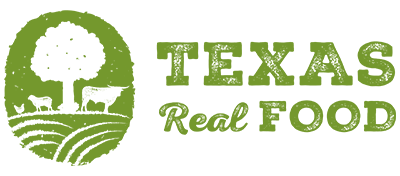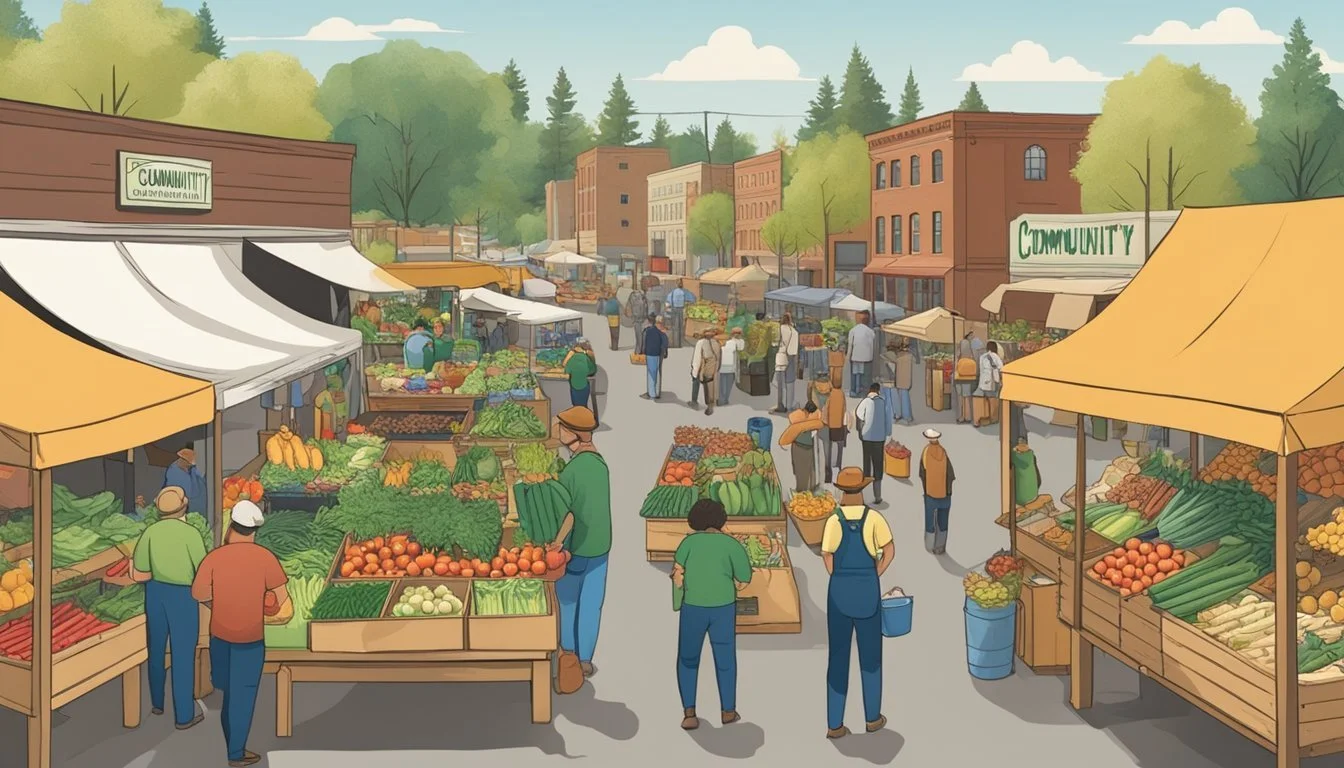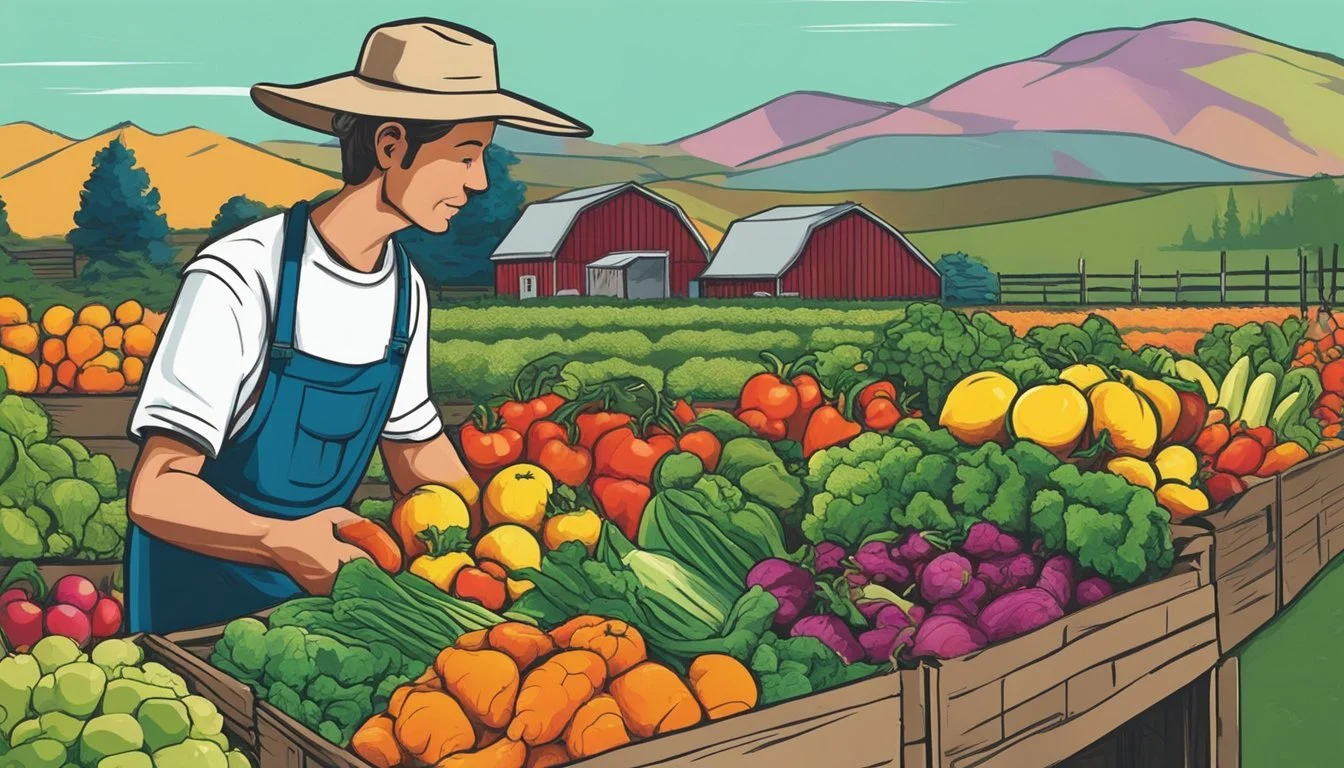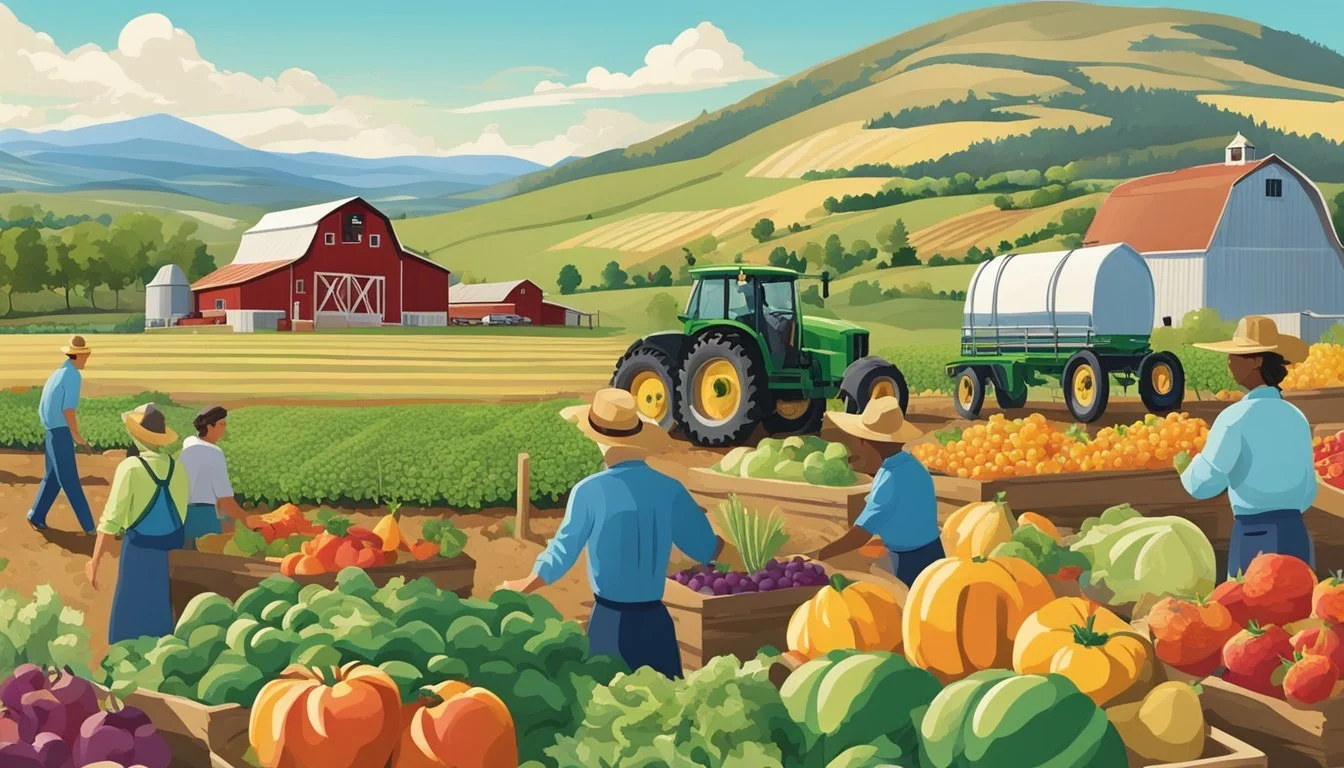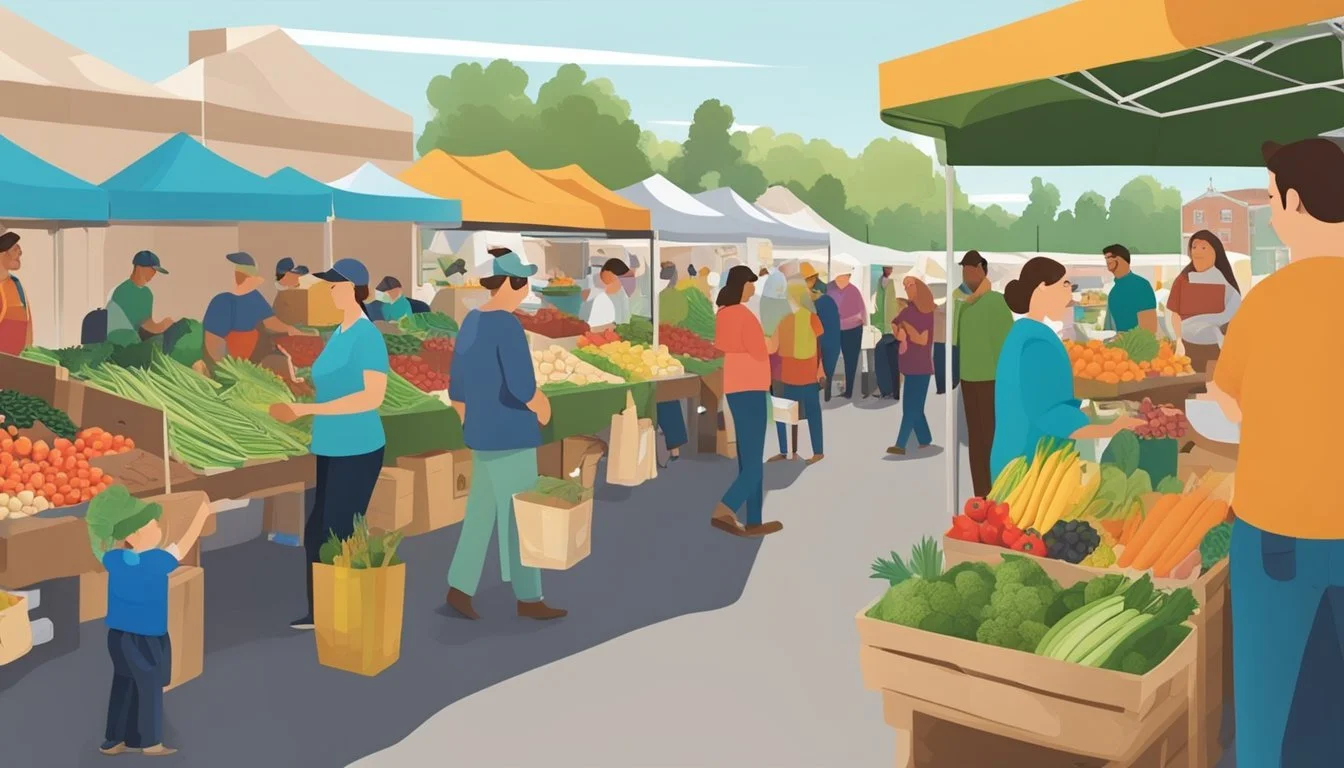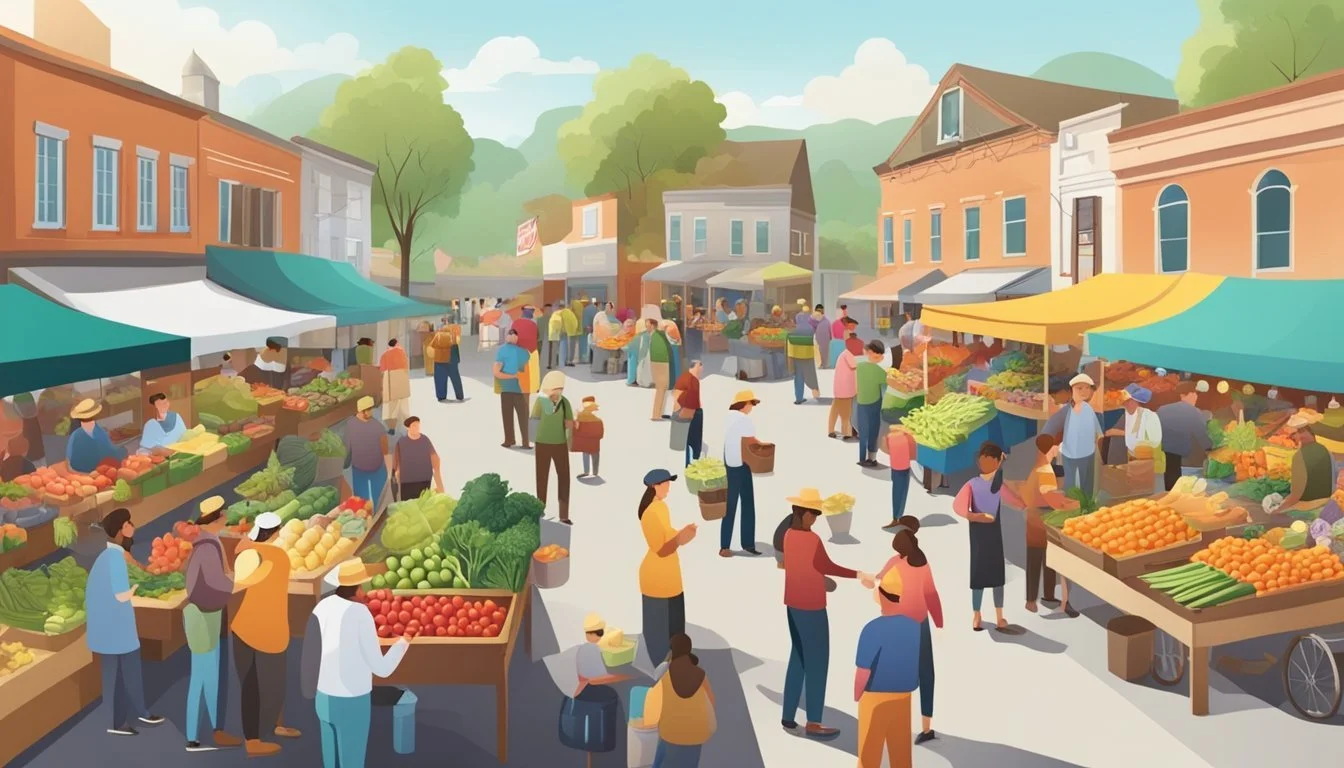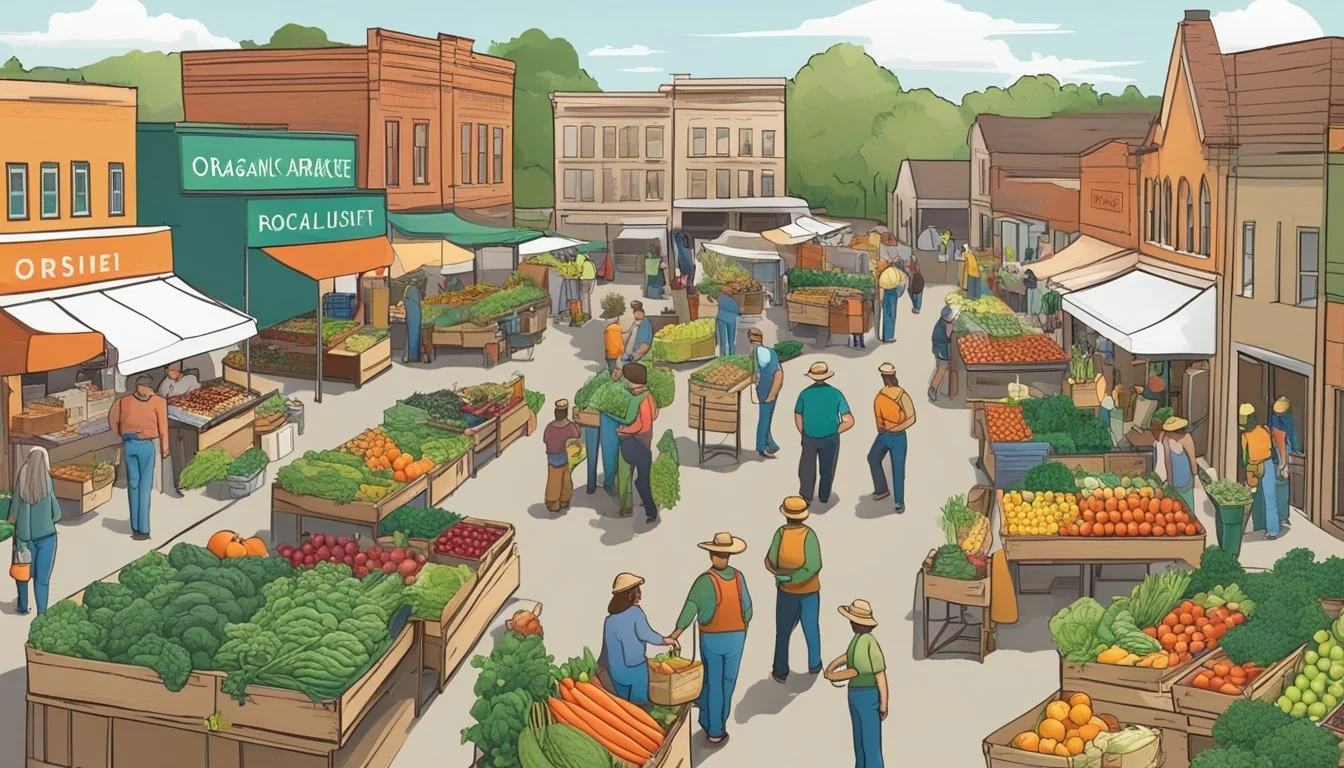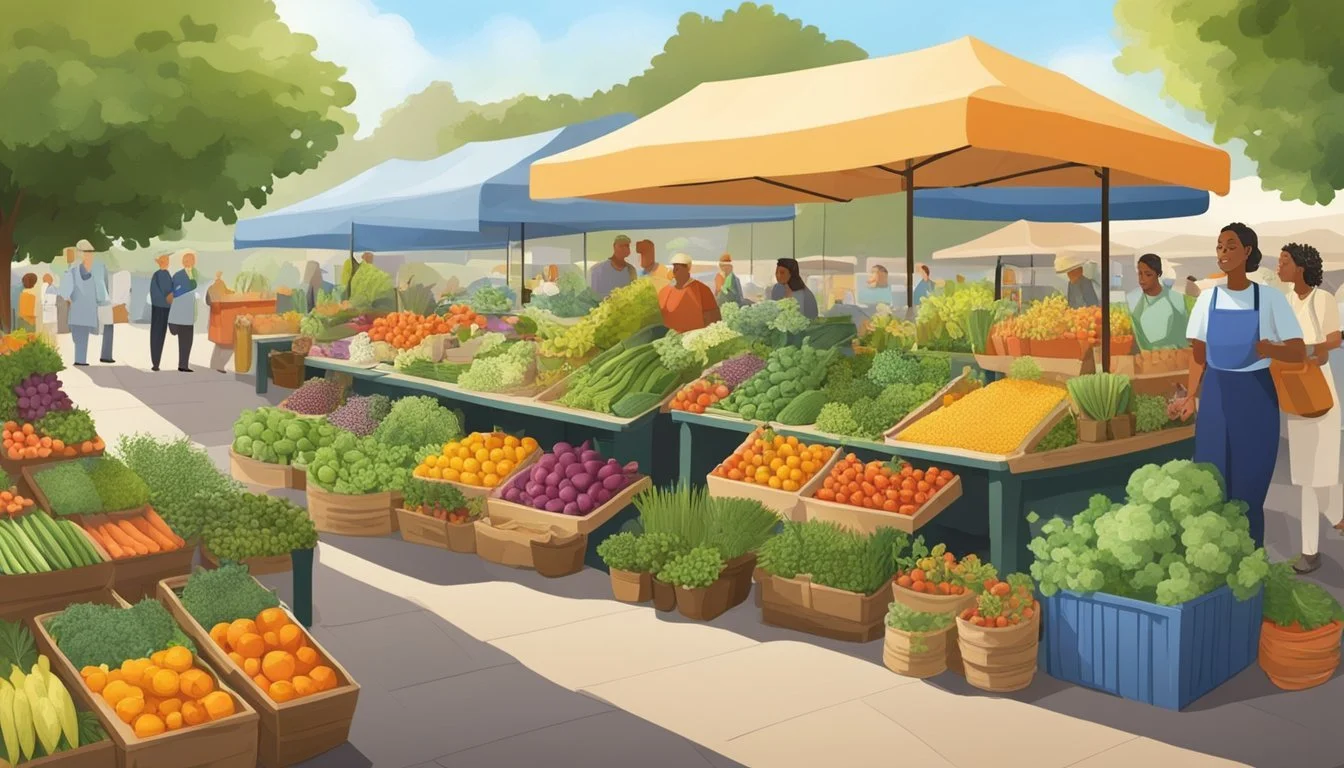Community Supported Agriculture (CSA) in Billings, MT
A Guide to Local Produce Subscriptions
Community Supported Agriculture, commonly known as CSA, has taken root in Billings, Montana, enriching the relationship between local farmers and community members. This agricultural model allows consumers to purchase shares of a farm's harvest in advance, securing a season's worth of fresh produce while providing farmers with upfront capital for their operations. In Billings, participation in CSA programs gives residents the chance to enjoy locally grown, often organic, produce while directly supporting the region's agricultural community.
The city's CSAs offer various benefits, including fresh and nutritious food options and the opportunity to engage with the source of their produce. These programs often cater to the needs of the community, as seen with CSAware management software, which aims to reach out to customers who utilize SNAP benefits. The CSA landscape in Billings stretches beyond individual farms to cooperative models, such as the Western Montana Growers Cooperative, which delivers shares to community members across the region.
Contributing to the sustainability and success of small-scale farming, CSA programs in Billings foster a sense of connection between the land and the table. Customers who subscribe to CSAs become partners with local farms, sharing the risks and bounties of agriculture. This relationship promotes a sustainable food system, encourages local economic growth, and builds a community around healthy, local food.
History and Concept of CSA
Community Supported Agriculture (CSA) represents a partnership between farmers and consumers where the responsibilities, risks, and rewards of farming are shared.
Origins of CSA
The inception of CSA is attributed to multiple influences, with significant roots in both European and Japanese agricultural movements during the 1960s. CSA emerged out of a need to address the disconnect between producers and consumers, and to provide a sustainable economic model for small farms.
CSA in the United States
Community Supported Agriculture gained traction in the United States in the 1980s, with Booker T. Whatley, an advocate for small-scale farming, pioneering the concept among African American farmers. The U.S. Department of Agriculture now recognizes CSA models for their ability to strengthen local food systems.
Jan Vander Tuin and the Spread of CSAs
Jan Vander Tuin brought the CSA concept from Switzerland to the United States in the mid-1980s. The establishment of the Indian Line Farm in Massachusetts marked one of the first CSAs in the U.S. Vander Tuin's efforts contributed significantly to the spread of CSAs across the country, providing a blueprint for the establishment of new programs.
Benefits of CSA
Community Supported Agriculture (CSA) in Billings, Montana, offers an array of advantages that resonate with local farmers, the community, and the environment. These include bolstering the regional agricultural economy, promoting sustainability, and enhancing health and nutrition.
Supporting Local Farmers
CSA programs are instrumental in providing financial stability to local farmers. They secure a pre-determined income from their CSA members, which allows them to plan and manage their farm operations more effectively. By subscribing to a CSA, community members directly support their local farmers and invest in their future yield.
Environmental Benefits
Sustainability is a cornerstone of CSA models. Farms that operate CSAs often employ environmentally conscious practices that foster biodiversity, soil health, and lower carbon footprints. Reduced transportation requirements also cut greenhouse gas emissions because the food does not travel as far to reach consumers.
Health and Nutrition Advantages
Members of CSAs benefit from access to fresh, seasonal produce. The nutritional content of harvested food is often at its peak, rich in vitamins, minerals, and antioxidants. This direct access to nutritious produce can contribute to a healthier diet and lifestyle overall.
Economic Impact
CSAs contribute positively to the regional economy. They keep money within the local community and encourage economic viability. The direct sale from farmer to consumer eliminates many of the financial pressures associated with traditional retail, ensuring more money stays with the agricultural producers and local economy.
In Billings, CSAs strengthen food security by providing consistent access to food supplies and fostering economic resilience among local agricultural businesses.
How CSAs Work
Community Supported Agriculture (CSA) connects consumers directly to their local farms, offering individuals the opportunity to subscribe to the seasonal produce a farm generates.
The CSA Model
In Billings, MT, the concept of CSA hinges on a relationship between local farms and community members. Subscribers, or shareholders, invest in a farm's production at the start of the growing season. This model allows farmers to cover initial annual costs and plan accordingly for the season's harvest, providing economic stability. In return, members receive regular distributions of fresh farm products throughout the growing season.
Shares and Memberships
Shares in a CSA are typically offered as memberships, where consumers pre-purchase a season's worth of produce. These memberships may vary in size and price, often designed to accommodate different household needs. For instance, a half-share might be suitable for individuals or small families, while a full-share might cater to larger households.
Seasonality and Variety
CSAs in Billings operate on a seasonal basis, meaning the produce available to members will change as the year progresses. This adherence to seasonality ensures that subscribers receive the freshest possible produce at peak ripeness. A notable benefit of CSA memberships is the variety of crops members are exposed to. Farmers plan diverse crop rotations, giving members a chance to experience new and traditional varieties of vegetables and fruits.
What to Expect from a CSA Share
When signing up for a CSA share, individuals can anticipate a diverse selection of farm-fresh products and the opportunity to engage with local agriculture in a meaningful way.
Typical Contents
Every CSA share is a reflection of what is seasonally available on the farm. Participants will generally receive:
A variety of vegetables such as tomatoes, carrots, and leafy greens
A selection of fruits including berries, apples, and perhaps melons
Seasonal vegetables that are freshly harvested at their peak
Herbs like basil, thyme, and rosemary to enhance the flavor of any meal
Seasonal Recipes
Accompanying many CSA shares are seasonal recipes to help members make the most of their bounty. These recipes are tailored to the contents of the weekly or bi-weekly share, encouraging members to explore:
Innovative ways to prepare vegetables and fruit
Techniques to incorporate herbs and seasonal vegetables
Diverse culinary uses for grains in side dishes or main courses
Additional Products
Beyond produce, CSA shares often include a range of other farm-grown or locally sourced items:
Week Products Included 1 Fresh eggs, a loaf of bread 2 Selection of meat, mixed flowers 3 Locally caught fish, a variety of cheese
Members might also find:
Handmade items such as jams or pickled vegetables (What wine goes well with pickled vegetables?)
Grains like quinoa or rice for well-rounded meal planning
Occasionally, special items such as honey or maple syrup
This section provides an understanding of what a CSA share typically includes, but the actual contents can vary based on the farm's offerings and the season.
Choosing the Right CSA
Selecting a Community Supported Agriculture (CSA) program is a significant decision for consumers in Billings, MT that can impact their household's access to fresh, local produce. Prospective CSA members need to assess their options carefully to ensure they join a program that best fits their needs.
Factors to Consider
When considering a CSA, individuals should evaluate several important factors:
Location: Proximity of the CSA to one's home can influence convenience and freshness.
Produce Variety: Some CSAs offer a wide range while others may specialize in certain crops.
Share Size: Determine whether a full or half share will suit the household's consumption needs.
Cost: Evaluate the financial commitment and payment plans available.
Season Length: The duration of the CSA season varies; it's crucial to know the start and end dates.
Questions to Ask
Prospective members should directly ask CSAs these essential questions:
CSA Experience: How long has the CSA been in operation?
Growing Practices: Are they using organic or conventional farming methods?
Pick-up Process: Where and when can shares be collected?
Support for SNAP: Does the CSA accept EBT or offer support for SNAP beneficiaries?
Using platforms like LocalHarvest can aid in finding precise information about the local CSAs and respective practices.
CSA Directories and Resources
To find a fitting CSA in Billings, one can utilize multiple resources:
LocalHarvest.org: Provides a comprehensive listing of local CSAs with user reviews.
Farmers' Markets: Often host booths or information stands for nearby CSA programs.
Social Media & Community Boards: Local community groups may share experiences and recommendations.
Individuals can also contact CSAs directly for tours or more detailed information.
The CSA Community
Community Supported Agriculture in Billings fosters strong connections between local farmers and consumers while offering an array of opportunities for participation and education within the community.
Building Relationships
CSA programs in Billings are designed to create more than just a buyer-seller relationship; they are about fostering a community. Danly Farms LLC exemplifies this by connecting 40 customers to the roots of their food since 2009, offering shares in the CSA that provide a regular supply of farm produce. These relationships help individuals and families connect with the rhythms of farm life and develop a deeper appreciation for local food systems.
Community Events
CSA farms in Billings often host events that turn eaters into active community participants. These events range from farm visits to harvest festivals where community members can meet the farmers, learn about sustainable agriculture, and form meaningful bonds with other like-minded individuals.
Farm Tours: Customers are invited to see where their food comes from.
Harvest Festivals: A seasonal celebration with food, activities, and community bonding.
Potlucks: Sharing meals underscores the value of community and local produce.
Education and Involvement
Educational programs are central to the CSA experience in Billings, with emphasis placed on teaching consumers and kids about the benefits of local farming and healthy eating. Western Montana Growers Cooperative, located in the broader region of Western Montana, demonstrates commitment to both education and involvement by providing direct deliveries to community members, thereby eliminating barriers to fresh, seasonal food.
Workshops: Topics include gardening, cooking, and sustainability practices.
Volunteer Opportunities: Individuals contribute to farm work for a firsthand experience.
Newsletters: Regular updates educate members about their food and farms.
Challenges and Considerations
In the landscape of Community Supported Agriculture (CSA) within Billings, MT, specific challenges demand attention for the model to thrive. These include aligning stakeholder expectations, addressing logistical hurdles, and balancing produce supply with member demand.
Managing Expectations
CSAs often thrive on the community's goodwill toward supporting local agriculture; however, managing expectations becomes vital. Shareholders may anticipate variety and volume akin to supermarket experiences, but must understand that CSA yields align with seasonal capacities and ecological farming practices.
Dealing with Inconvenience
CSAs may present inconvenience when compared to the ease of supermarket shopping. Pickup locations and times can challenge members accustomed to the 24/7 availability of grocery stores. CSAs need effective communication strategies to ensure member convenience without compromising the essence of the CSA model.
Addressing Supply and Demand
The equilibrium of supply and demand remains a delicate balance in CSA operations. On one side, there's the unpredictability of farming yields; on the other, the anticipated demand from shareholders. Farmers must expertly predict and plan for the fluctuating demand to maintain a sustainable operation without overproducing or underdelivering.
Support and Incentives
Community Supported Agriculture (CSA) programs in Billings, Montana benefit from various support and incentive schemes. These programs ensure the viability of CSAs and provide access to fresh produce for a wider demographic.
Government Programs
The U.S. Department of Agriculture (USDA) recognizes the importance of CSA programs in supporting local farms and fostering community engagement. They collect data on CSA operations to evaluate their impact and guide government support. It has been reported that in 2020, CSA programs accounted for $225 million in direct-to-consumer sales across the United States.
SNAP Benefits and CSAs
CSAs in Billings are increasingly accommodating Supplemental Nutrition Assistance Program (SNAP) benefits, opting to make healthier food choices more accessible to low-income individuals. By integrating SNAP payments, CSAs expand their customer base to include those who might otherwise be unable to afford fresh, local produce.
Key Tips for SNAP Outreach:
Consider budget and time constraints.
Weigh cost against potential benefits of various advertising methods.
Local Initiatives
Local initiatives in Billings actively support CSAs through cooperative efforts. One such example is the Western Montana Growers Cooperative, which, apart from facilitating CSA distributions, offers direct deliveries to community members. These initiatives not only bolster CSA operations but also solidify community relations, ensuring that consumers and farmers alike benefit from the market's progress.
Impact Beyond Billings
Community Supported Agriculture (CSA) in Billings has served as a catalyst for spreading the CSA model throughout Montana and influencing similar practices in other regions. These initiatives promise to sustain local agriculture, enhance food security, and foster community ties well into the future.
CSAs in Montana
Montana has witnessed a rise in CSA programs, with Missoula being home to the Western Montana Growers Cooperative. This cooperative supports local farmers by providing fresh produce to members across the region, reinforcing the local food movement. Further east, programs in Bozeman are bolstered by educational and research efforts from Montana State University, which promote sustainable agriculture practices and help cultivate organic farming techniques.
Influence on Other Regions
Montana's CSA success has carried over to other areas, such as the Central Coast, where the principles of direct, community-supported farm-to-consumer sales are taking root. The reach of CSA extends beyond state lines, establishing a network that supports organic farms and ensures that consumers have access to healthful, seasonal food options.
Future Prospects
The prospects for CSA programs are robust, encouraged by a growing consumer interest in both the origin and nutritional value of their food. As CSA continues to evolve, the model is likely to inspire more innovative agriculture methods and community participation, ensuring sustainable growth and a stable market for local produce in Montana and beyond.
Getting Involved Locally
Community Supported Agriculture (CSA) presents Billings residents with opportunities to engage directly with local food movements. Whether through securing fresh produce, volunteering, or participating in local events, involvement underpins the community's commitment to sustainable agriculture.
Finding a CSA in Billings
Billings, MT, offers several CSA options where community members can subscribe to receive seasonal produce directly from local farms. Interested individuals can:
Research Local Farms: Local farms such as Danly Farms LLC have been providing CSA shares to the Billings community, offering around 40 customers a chance to participate in the local food economy.
Visit Farmers' Markets: Farmers' markets often have information booths or representatives from CSAs. Billings residents can find details on subscription options and sign-up opportunities at these markets.
Use Online Resources: Various online directories list CSA farms in and around Billings, including Bozeman and Western Montana areas, which can be a starting point for those looking to join a CSA program.
Volunteering and Community Partaking
Volunteering at local CSA farms or food movements allows individuals to support local agriculture and potentially gain access to fresh produce even for low-income households. Here are ways one can volunteer:
Assist in Farms: Farms may seek volunteers for various tasks, offering hands-on experience with sustainable farming practices.
Participate at Farmers' Market: Engagement as a volunteer at Billings farmers' markets can help support local vendors and foster community connections.
Local Food Movements
Being part of a local food movement means embracing a system that supports local farms and provides food security through sustainable practices. Key aspects include:
Seasonal Eating: Local food movements in Billings encourage eating seasonally, which supports the CSA model of consuming what is grown locally and when it's at its peak.
Education and Outreach: Educational programs and outreach efforts are often associated with CSAs and local food movements, aiming to inform the community about the benefits of supporting local agriculture.
Engagement in Billings' local food scene through CSAs, farmers' markets, and volunteer initiatives is a robust way to foster a resilient food system.
Understanding Organic and Non-Organic Options
In Billings, MT, consumers have distinct choices between organic and non-organic Community Supported Agriculture (CSA) options. Each choice has implications for pesticide use, farming practices, and consumer health.
Organic Certification
Organic CSA options in Billings adhere to stringent standards for organic certification. Certification requires farmers to avoid synthetic pesticides and fertilizers, employ soil and water conservation techniques, and promote biodiversity. Organic farms must undergo regular inspections to ensure compliance with the United States Department of Agriculture (USDA) organic standards.
Pesticide Use
Pesticide use is a key differentiator between organic and non-organic CSA products. Organic farming practices include the use of natural pesticides and holistic pest management strategies. In contrast, non-organic options may utilize synthetic pesticides to protect crops. Consumers often choose organic CSAs to reduce their exposure to these synthetic pesticides.
Consumer Choices
Consumers in Billings face a range of choices when selecting a CSA:
Organic CSA: Usually more expensive due to the cost of sustainable farming practices, but preferred for its environmental and health benefits.
Non-Organic CSA: Often less costly and might offer a wider variety of produce, appealing to those not prioritizing organic standards.
Whether choosing an organic or non-organic CSA, consumers directly support farmers and have a closer connection to their food source, fostering a resilient, local food system in Billings.
Culinary and Medicinal Uses
Community Supported Agriculture (CSA) programs in Billings, Montana, offer a diverse range of fresh produce that can be used in a variety of culinary applications and provide numerous health benefits due to their organic nature.
Cooking with CSA Ingredients
Members of the community who participate in CSA programs often receive a wide array of vegetables and herbs that can elevate their cooking. Fresh peppers, known for their ability to add both heat and a depth of flavor, are a popular CSA staple. Experimenting with new vegetables from a CSA share can introduce unexpected textures and flavors to everyday meals. It's an opportunity to explore the potential of each ingredient, from aromatic herbs that can be used for seasoning to vibrant vegetables that serve as the foundation of dishes.
Example CSA Share Cooking Guide:
Peppers: Incorporate into stir-fries, roast for a smoky flavor, or stuff with grains and proteins.
Herbs: Enhance sauces, dressings, or use as garnish to add complexity to any meal.
New Vegetables: Try roasting to concentrate flavors or blending into soups for hearty meals.
Health Benefits of Organic Produce
The organic produce found in CSA shares often comes with an array of health benefits. Such produce is typically grown without synthetic pesticides and fertilizers, which means it may contain lower levels of potentially harmful residues. Fresh produce is a key source of vitamins and antioxidants, which are crucial for maintaining good health. Medicinal herbs from CSAs can be used to naturally support health, offering therapeutic properties that have been recognized for centuries.
Key Nutrient Highlights:
Vitamin C: Found in abundant supply in fresh peppers, contributing to immune system support.
Antioxidants: These are present in many vegetables and can help neutralize free radicals in the body.
By incorporating CSA ingredients into their diet, individuals can explore a range of culinary uses while benefiting from the medicinal qualities of organic produce.
